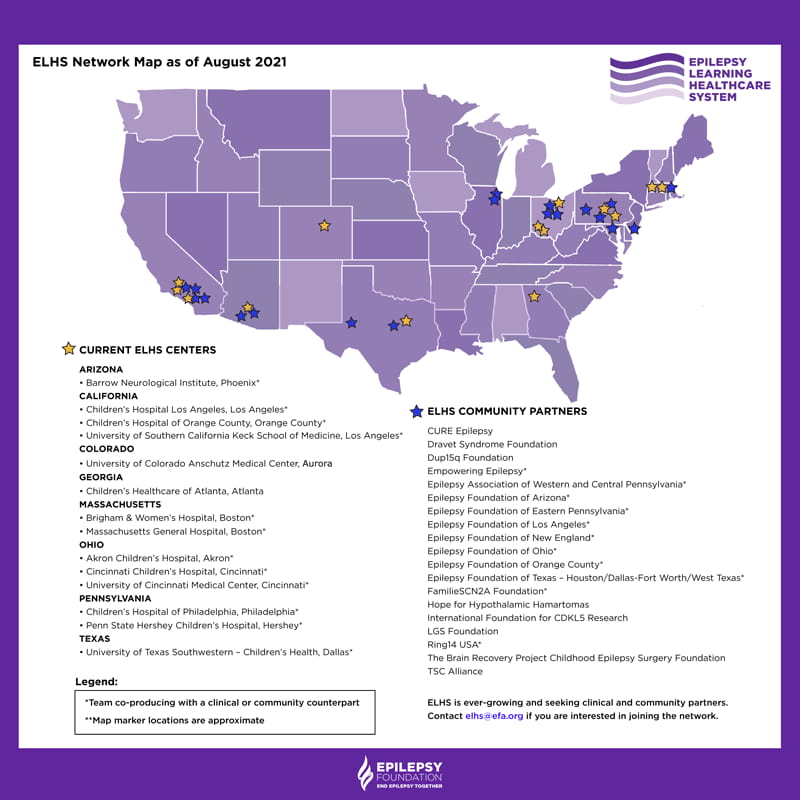ELHS Virtual Learning Session: Resiliency During a Crisis

Epilepsy News From: Tuesday, May 19, 2020
Due to the coronavirus pandemic, the Epilepsy Learning Healthcare System (ELHS) 2020 spring Learning Session went virtual. The event welcomed 115 representatives from community and clinical teams.
The session provided an opportunity for participants to share their experiences with standardizing the way they document seizures for all patients, routinely screening for barriers to medication adherence, and optimizing telemedicine visits. It also offered an opportunity for participants to learn from partners across the network and collaborate on possible solutions.
State of the ELHS
The mission of ELHS is for all people with epilepsy to live their highest quality of life, striving for freedom from seizures and side effects, and we won’t stop until we get there.
To represent this vision and how the ELHS will get there, the ELHS symbol is a flag with four purple stripes. Each stripe represents a partner in the ELHS. They include:

- People living with epilepsy and their families
- Health care providers
- Community services
- Researchers
Chief Outcomes Officer Dr. Brandy Fureman opened the session with a reminder of how the ELHS works together to create the change needed for people with epilepsy and their families, and how we’ll get there.
“The way the ELHS works is that we build teams at clinical centers and community service organizations across the country,” said Dr. Fureman. “We involve patients and families at every stage of the work. We are bringing the community and clinical elements together to offer comprehensive care for the whole person.”
The ELHS currently includes 13 epilepsy center teams, 23 community organizations, 6 patient family partners, and 11 sponsors.

Ignite Talk: Personal and Professional Perspective
The event included two talks that highlighted how families and professionals are coping with the COVID-19 pandemic.
Family Perspective
Yssa DeWoody PhD, co-founder and director of Ring14 USA and caregiver of Marie, her daughter who is affected by Ring Chromosome 14 Syndrome, shared their recent experience in a COVID-19 hospital ward. Ring 14 is a severe, drug-resistant epilepsy that comes with many challenges for care. Over the years, Yssa’s family has seen slow declines in Marie’s abilities - declines in communication skills, mobility, and general autonomy. Years of relentless, severe seizures have taken a toll. Her pneumonia and tendency to aspirate have also become worse.

During a pandemic, avoiding the emergency room when possible is advised. But for the families who have a higher likelihood of medical emergencies, like Yssa’s family, this isn’t always a choice.
“Nothing magically changes during COVID-19,” said Yssa. “COVID-19 becomes another layer in the care of Marie.”
Clinical Perspective
Telemedicine became an emerging hot topic almost immediately when COVID-19 arrived in the United States. Many health care settings had to rapidly transform their practices to continue serving their patients. During the learning session, Dr. Christi Heck at the University of Southern California (USC) shared her institution’s experience setting up telemedicine.
Pre-COVID-19, transition to a virtual environment for follow-up visits took a full year with extensive review at every stage. In December 2019, USC was able to start adopting telemedicine. With the arrival of COVID-19, this process accelerated dramatically. Both new patients and follow-up visits were transitioned to telemedicine and 88 USC clinics were providing telemedicine in the beginning of March.
Telemedicine in the ELHS Network
Across the ELHS network, telemedicine has offered both hope and challenges. Before the pandemic, more than 80% of ELHS-affiliated epilepsy centers had little to no prior experience with telemedicine. This has rapidly changed with a great deal of collaboration, hard work and living the Quality Improvement (QI) mantra: “start before you’re ready.” While telemedicine offers many benefits to people living with epilepsy, there are challenges for both families and professionals.
These challenges include:
- Some families distrust technology like Zoom and have concerns about privacy.
- Patient access to the technology needed for televisits isn’t guaranteed.
- Constant innovation is necessary to keep technology up and running.
- Difficulty assessing how much a patient understands without seeing their face or physical reactions.
- Some symptoms are hard to review medically over telemedicine.
- Rural communities have internet access issues.
- Filling out forms about seizure frequency and other health information is more difficult.
These challenges, however, may be balanced out by the benefits they offer people living with epilepsy and their families.
Other Meeting Highlights
Other key meeting highlights included:
- ELHS reported 92% of providers documenting seizure frequency for their patients. This is an increase from 53% when ELHS began two years ago.
- People with epilepsy and their families continue to face barriers related to taking medication as prescribed. Barriers to medication in children are often more complex than in adults living with epilepsy, as is the case in the overall journey much of the time. Constant evaluation on how to tackle these challenges are necessary.
- The ELHS network continues to adjust to a COVID-19 world. Data forms to gather patient information and input are being shifted to be more web friendly for ease of use both by clinicians and people with epilepsy
Pam Jacques, executive director of Epilepsy Foundation Ohio, shared during the event the value of hearing the clinical perspective.
“It really helped me to hear a clinician's perspective,” said Pam. “It will change my messaging with the population I serve regarding addressing the importance of continuing seizure documentation during COVID-19."
At the end of the Learning Session, participants shared one word to reflect how they felt about the event. The following word cloud reflects participant choices.

Authored by
Liz Dueweke MPH
Reviewed by
Brandy Fureman PhD
Reviewed Date
Tuesday, May 19, 2020
